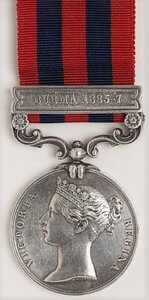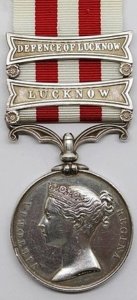‘Hollowell of the deadly rifle’
c.1825-1876
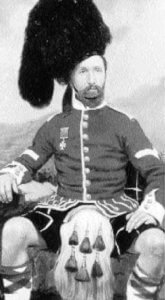
Hollowell, VC
1825-1876
Lance Corporal James Hollowell (occasionally spelt ‘Holliwell’), VC, the son of John Thomas Hollowell, a carpenter, and his wife Sarah, was born in Lambeth, London, about 1825.1 Aged about 33, James was awarded the Victoria Cross for valour displayed during the Relief of Lucknow, in Bengal, India. He died in London, in 1876, and was buried in the Corps of Commissionaires plot at Brookwood Cemetery, near Woking, in Surrey.
James became a Private, serving in India with the 78th Regiment of Foot, Queen’s Own Highlanders (later the ‘Seaforth Highlanders’), which had been raised in Rossshire in 1793. (The proportion of Scots in the regiment had begun to decline in the 1840s, after replacements for forces lost during the First Anglo-Afghan War (1837-42) were recruited from across the entire United Kingdom).2
The Anglo-Persian War
During the winter of 1856-7 James served in the brief Anglo-Persian War waged between the United Kingdom and Iran. Resisting Iranian claims on the city of Herat, the British campaigned on two fronts – Busshehr (on the South coast of Persia), and Southern Mesopotamia. Their victory at Khushab in February 1857 was considered so decisive that Lieutenant General James Outram, who led the campaign, was awarded the Grand Cross of the Bath (GCB).
The Relief of Lucknow
Shortly afterwards James’s regiment returned to India, and became embroiled in attempts to quell the Mutiny (‘First War of Independence’) which erupted at Meerut in May 1857.
By September of that year James was serving under Major-General Sir Henry Havelock, attempting to relieve the siege at Lucknow, Bengal. On 26 September 1857 James successfully defended a burning house in which he and nine ‘dispirited’ men were being besieged by rebel sepoys, who were firing at them through four windows. James reportedly ‘behaved throughout the day in the most admirable manner’. By ‘exposing himself fearlessly’ and using his talents to direct, encourage and lead the others, he and the group managed ‘to make a successful defence’.3
Surgeon Anthony Dickson Home, who was also awarded a VC, described the day’s events in more detail:
‘Private Hollowell, a straggler from the 78th Highlanders, was the crack shot of our little band. Whenever the enemy came forward to storm the house, he repeatedly killed the foremost man; and the rest fell back. At last, he had the opportunity of taking a long shot at their chief leader – a vociferous old man with a red beard and turban, and armed with a sword and shield – who died on the spot. After that, most of the enemy went away. And none too soon, as we had only seven rounds left to fire’.4
Referred to as a ‘straggler’ on that day, when the troops under Major-General Havelock forced their way into the Residency of Lucknow, James was part of the group assigned to escort the wounded men who had been left behind by the main column. The escort group was ‘reduced to a few stragglers’ (Hollowell, Home and ‘seven more staunch soldiers’), when several members themselves became casualties.
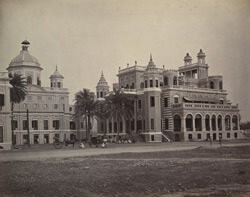
(Samuel Bourne, 1860s)
After becoming separated from the main column this small party, and the wounded men in their care, found themselves isolated in ‘Dhooley Square’, outside the Farhad Bakhsh Palace. They were forced down ‘a cramped lane overhung with houses’, inside one of which ‘they defended themselves till it was set on fire’. They then retreated to a shed a few yards away, and ‘continued to defend themselves for more than twenty-two hours, till relieved’.
James was recommended for a Victoria Cross for his actions on that day, and promoted to Lance Corporal.5 On 15 June 1858 he was presented with his VC by Outram (Havelock having died in the meantime).
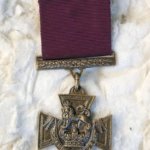
The Victoria Cross had been introduced by Queen Victoria in 1856, to honour acts of valour conducted ‘in the presence of the enemy’. Worn with its distinctive crimson ribbon as the first decoration in a row of medals, it takes precedence over all other orders, decorations and medals. Altogether 182 Victoria Crosses were awarded for acts of valour performed during the Indian Mutiny. Recipients were granted an annuity of £10 per annum.6
Corps of Commissionaires, London

6 Apr 1862
James’s regiment left India and returned to the UK in 1859. Proudly declaring his ‘rank or profession’ as ‘V.C.’, and his age as ’37’, James married Sarah Whicher at St Mary’s Church, Spital Square, Whitechapel, London, on 6 April 1862. Sarah, the daughter of James Whicher, a millwright, had been born in Camberwell. At the time of their marriage the couple were living at Commercial Street, London. The ceremony was witnessed by Sarah and Emma ‘Holliwell’.
Over the next few years James and Sarah had three sons: George, Thomas and James. After working for some time as a labourer,7 ‘Hollowell of the deadly rifle’, as he became known, joined the Corps of Commissionaires, which had been founded in 1859 to provide employment for military veterans. James, a ‘square-built, upright man in a policeman’s uniform, on the breast of which are many medals and the Victoria Cross’,8 kept order on the street outside E Moses and Son, a gentleman’s outfitters on New Oxford Street, London.
The firm regularly advertised in the London press as ‘Merchant Tailors and Outfitters for all Classes’, selling ‘every description of clothing, readymade or made to measure, for all ages, all occasions and all classes’. An indication of James’s working hours is given in the note about their opening hours: ‘E Moses and Son’s Establishments are closed every Friday evening at sunset, till Saturday at sunset, when business is resumed until Eleven o’clock’. 9
The ‘many medals’ on James’s chest which accompanied his Victoria Cross included the India General Service Medal, and the India Mutiny Medal. James’s India General Service Medal had one clasp, ‘Persia’, awarded for his service in the Anglo-Persian War under Lieutenant-General Sir James Outram. His India Mutiny Medal had two clasps: the first, ‘Defence of Lucknow’, referred to his role in the relief force, led by Major-General Sir Henry Havelock; the second, ‘Lucknow’, to his service in the eventual recapture of Lucknow, led by Lieutenant-General Sir Colin Campbell.
with clasps ‘Defence of Lucknow’ and ‘Lucknow’
In 1867 James was interviewed several times by Archibald Forbes, a prominent war correspondent, to whom he supplied detailed, colourful descriptions of his Asian military experiences. Forbes paid him 5 shillings for each interview, on the understanding that he might use James’s reminiscences as background material for a novel about the Indian Mutiny, to be serialised in his journal ‘The London Scotsman’ (which ran from 1867-71).10
On his 1871 census return James described himself as a ‘Beadle’, aged 46, living with his wife Sarah and their children at 20 Gloucester Street, Holborn, London.11 He died there, aged about 51, on 4 April 1876, and was buried four days later in an unmarked grave in the Corps of Commissionaires Plot at Brookwood Cemetery, Surrey.
After his death James’s family continued to live in the Whitechapel area. Census returns show that his widow, Sarah, became employed as a ‘Church Attendant’. Their eldest son, George, became a ‘Librarian’ and, later, an ‘Assurance Agent’ with the Prudential; Thomas progressed from being a ‘Telegraph Messenger’ to a ‘Post Office Clerk’, and, eventually, ‘Overseer, London Postal Services’. Their youngest son, James, who was only 7 years old when his father died, was educated at the Royal Military Asylum, Chelsea, following which he served with the Royal Artillery until his death at Nova Scotia in 1895.
Commemorating James Hollowell, VC
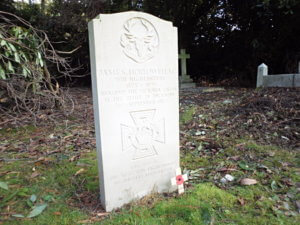
Brookwood Cemetery
In 2019 James’s Victoria Cross, allegedly cast from bronze taken from a gun captured at the Siege of Sevastopol (1854-55), was placed on public display at the Regimental Museum of the Queen’s Own Highlanders, at Fort George, near Ardersier, Invernessshire, Scotland. (Prior to this date the museum’s medal collection had been kept in ‘secure storage’, with replica medals being displayed to the public).
In October 2020 James’s regiment erected a permanent memorial to him, in the form of a CWGC (Commonwealth War Grave Commission) pattern headstone on Plot 125 (the Corps of Commissionaires plot), at Brookwood Cemetery.
By BACSA member Rachel Magowan
References
1 Hollowell, James, bapt. 8 Jan 1826 (Baptism Certificate). Together with James’s own age declarations at marriage (aged 37 in 1862) and on a census return (aged 46 in 1871), this date of baptism suggests that James was probably born in 1825. However, on the gravestone (erected by his regimental association in 2020), his year of birth is shown as 1823.
2 Fairrie, Lt Col Angus, 1998, ‘Cuidich’n Righ’: A History of the Queen’s Own Highlanders (Seaforth and Camerons). Quoted in: Wikipedia (78th Highlanders)
3 Outram, Sir James, GCB, Major General, 14 Oct 1857, Extract from Divisional Orders
4 Victoriacrossonline.com
5 Gazette, 18 Jun 1858
6 Original Warrant, Clause 14 (Wikipedia)
7 Holliwell, George Jonathan, 17 Jan 1864 (Baptism Certificate), shows his father James’s ‘Quality, Trade or Profession’ as ‘Labourer’.
8 Daily News, 10 Feb 1876
9 Bee-Hive, 12 Feb 1876
10 Victoriacrossonline.com
11 UK Census, 2 Apr 1871

